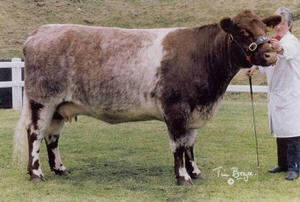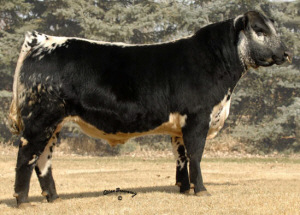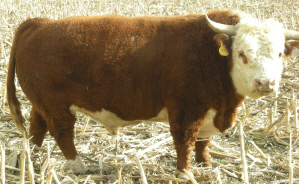



Beef Shorthorn
History
The Shorthorn breed of cattle, which we know today, has evolved over the last two centuries, from Teeswater and Durham cattle found originally in the North East of England. In the late 18th Century two brothers, Charles and Robert Colling started to improve these Durham cattle using line breeding techniques established so successfully by Robert Bakewell on Longhorn cattle. In 1783 Charles Colling found four particular cows recorded as Duchess, Cherry, Strawberry, and Old Favourite among others, and at the same time his brother Robert had noticed the superiority of calves in the local market bred from a bull known as Hubback, which he subsequently bought for £8.
It was a combination of these bloodlines, which led to the birth of the bull Comet bred by Charles Colling in 1804, and later sold at the Ketton sale in 1810 for 1,000gns. This was the first 1,000 guinea bull ever recorded, but the wisdom of this bid was later to be justified by his progeny and he has since become a legend in cattle breeding.
Other outstanding breeders at this time, Thomas Bates of Kirklevington, and John Booth of Killesby were developing the Teeswater cattle, and their names and fame live on today. The Bates strains were subsequently developed for their milking qualities, whereas the Booth families were developed for their beef qualities. Both were convinced of the value of inbreeding or line breeding to a degree previously considered unacceptable in cattle breeding.
The breed was used in the early part of the 20th Century, primarily as a dual purpose breed, but specialisation for beef and milk led to the beef breeders starting their own section of the herdbook in 1958. Since that time the Beef Shorthorns have been developed as a separate breed, and in 1976 in an effort to improve the muscling in the breed, the Directors of the Beef Shorthorn Cattle Society sanctioned the use of Maine-Anjou blood into the breed. The Herd Book was then closed again to outside blood in 2001, except by introduction through the Grading Register.
In Ireland, the majority of Shorthorns are used for their suckler/beef capabilities, whereas in the UK the milking qualities of the breed have been developed.
The importance of the Shorthorn breed in the development of other cattle breeds is enormous, and Shorthorn genetics have been used worldwide in the development of over 40 different breeds. The breed has a very long and distinguished history, and developments on both the beef and dairy sides have ensured that the breed also has a very bright future.
Characteristics
Beef Shorthorn come in three colors, red, white and roan. Red cattle may be solid red or have white markings and they can be horned or polled. They are bigger than their dairy counterparts and are grown specifically for their beef.
Solid red Shorthorn are often used to help maintain solid colors in crosses. The whites and roans can be used on black cattle to get both blues and blacks.
Shorthorn bulls are active aggressive breeders and we get many reports of bulls being used in commercial herds for several years, often up to eight years.
An advantage of the Shorthorn cross is that the steers produced have an excellent rate of gain, good feed conversion and increased marbling and tenderness
Overall the Shorthorn is the ideal breed for the production of a choice high quality beef with its suitability for extensive and organic farming systems and its proven marbling and early finishing abilities.
Statistics

Photo courtesy of Redhill pedigree Livestock, www.beefshorthorn.org |
Calving Ease - All cattlemen agree, more live calves at birth means more calves at weaning. Shorthorn cross females calve unassisted 98% of the time. Shorthorn calves average 85 pounds at birth; therefore reasonable birth weights result in calves having a higher potential for growth.
Fertility - Iowa State University research has stressed that reproductive efficiency is 100 times more important to economical viability than selection for carcass traits. Shorthorn bulls are aggressive breeders, and are an ideal selection for use in rotational crossbreeding programs for high conception rates with minimal maintenance. Shorthorn heifers have proved to be among the earliest to reach puberty at 359 days.
Growth ability - Shorthorn bulls and females readily transmit the ability to grow quickly and efficiently.
Crossbreeding - increases productivity through enhanced levels of performance for particular traits due to heterosis. Specifically, crossbreeding with Shorthorn cattle offers increased calving ease, docility, fertility, growth and carcass quality.
Comparative
In a recent Cargill "Beefworks" project, 290 Shorthorn sired steers had an average yield of 60.52%, AAA grade of 53.1% and an average daily gain of 3.0 lbs./day, with a feed conversion of 6.5 lbs. dry matter/lb. gain. A premium of $9 per hundred weight was received on the AAA steers over those grading A. This amounts to nearly $7000 extra for every 100 steers making the AAA grade.
Distribution
Beef Shorthorn can be found around the world in suckler and commercial herds from the UK to the USA, Canada, New Zealand and Australia.
References (the above information was cited from the following sites)
(Headline photo courtesy of Muridale Shorthorns, www.muridale.com)


